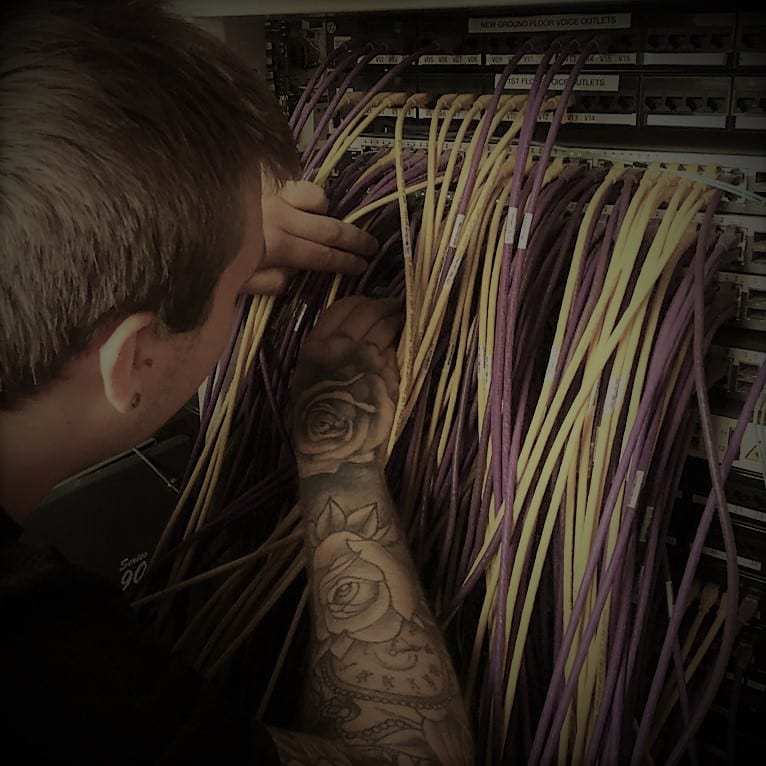Data Cabling Cat 5 / 6 / 7 / 8 cabling. What’s the difference?
Data Cabling. For many enterprises, copper wire remains the material of choice for data cabling. Variations in manufacture, shielding materials, and other factors result in there being a range of grades or categories, each with different levels of noise resistance, transfer speeds, backwards compatibility, physical robustness, and cost efficiency. Anticipated length of use, desired performance levels, network configuration and physical considerations will all influence the choice of which category of data cabling to use.
The fast and stable transfer of information is a vital part of any business today, and your choice of data cabling lays a foundation stone for the network infrastructure that makes these connections possible.
For many enterprises, copper wire remains the material of choice. But not all copper cables are the same. There are variations in manufacture, shielding materials and other factors that result in a range of grades or categories of cabling. Each category has its own plus and minus points, and its own ideal range of applications.
In this article, we’ll be looking at these differences, and considering which categories of data cabling are most appropriate for various environments and operating conditions.
Conditions Affecting Your Choice Of Data Cabling
Physical location factors into deciding which type of data cabling to use at your business premises.
As a rule of thumb, freshly installed copper cable has a service life of ten years. If your offices are rented, even with a long term contract, you may be unwilling to invest a huge amount in wiring, with the possibility of having to relocate before you can benefit from its full capacity.
If you own your business premises, this may influence a decision to install the highest performing and longest lasting cable solution that your budget allows.
The level of performance you expect from your business communications and data networks will also play a part in determining your choice. Each of the distinct cabling categories that we’ll discuss has its own performance benefits and drawbacks, and optimal conditions of use.
The physical placement of cables and their proximity to possible sources of electrical interference will affect not only your network cabling configuration but also the materials that you choose. Certain categories of cable are manufactured with more twists per inch and better shielding than others. This can have a serious impact on what’s known as “crosstalk” – electromagnetic signal interference which occurs when several cables are near to each other.
Beyond these technical and physical considerations, you’ll need to partner with an organisation like LG Networks which can guarantee expert advice and assistance in the design, installation, testing, service and maintenance of your data cabling system.
Why There Are Different Cabling Categories
Over the years, entire generations of copper twisted pair and fibre optic cables have been upgraded and standardised by organisations like the Institute of Electrical and Electronics Engineers(IEEE). Each new category has sought to improve on previous versions, in terms of data transmission speed, bandwidth capacity, and the ability to cancel out noise and signal interference.
Some earlier categories of data cabling have been phased out. Of those that remain, these are the ones that are most widely used, together with their most common applications:
Cat 5 Cabling
Category 5 or Cat 5 cabling (often written interchangeably as Cat5) is also known as Fast Ethernet, from a term coined by Robert Metcalfe, referring to the full spectrum of twisted copper and optical fibre cables.
Standardised in 1995, Cat 5 introduced 10/100 Mbps Ethernet over distances of up to 100 metres. Some older IT deployments using Category 5 still exist, as it’s a low-cost option for simple network set-ups.
Officially ratified in 2001, the Cat5e or Category 5 Enhanced standard delivers lower noise and less potential for crosstalk interference, and has largely overtaken Cat 5. Using four data pairs for Gigabit Ethernet, Cat 5e supports transmission speeds of up to 1000 Mbps. Rated transfer speeds of up to 350 Mbit/s may be achieved over 100 metres.
It’s another low-cost option that may be used in commercial spaces, but also finds applications in the home. If your network is likely to require greater speeds in the near future, Cat 5e data cabling may not be capable of accommodating this.
Cat 6 Cabling
Cat 6 is now the default cable for most network installations. Offering an excellent balance of speed and distance at only a marginal material cost increase over Cat5e, whilst offering gigabit connections up to 100m. It requires more care during installation, paying particular attention to bend radii and other guidelines can impact on the containment required but it is still the expected option on all new installations.
Power over Ethernet (PoE) is a technology for wired Local Area Networks (LANs) which allows electrical current for device operation to be carried via data cables, rather than power cords.
Cat 6 cabling is highly recommended for PoE, and can also readily handle audio and video applications. Introduced in 2002, Cat6 cables are more tightly wound than Category 5, and feature two or more twists per cm. They also have thicker sheaths than Cat5e cables, which increases their resistance to crosstalk.
Category 6a (the “a” is for Augmented) can support 10 Gigabit Ethernet at 100 metres. It also supports bandwidth frequencies up to 500 MHz (twice that of Cat6), and has more robust sheathing to reduce crosstalk even further.
Category 6 and 6a cables are advised for business users who own their work premises, or have a guaranteed long-term lease. They’re also a preferred option for “future-proofing” your network installation, with their support for higher data rates for emerging applications. The strong and thick sheaths covering Cat 6a cables, and their relatively low cost make them ideal for use in industrial environments.
Cat 7 Cabling
Cat 7 cable uses extensive shielding, with both individual pairs being shielded, along with a separate layer of shielding over the entire cable. This reduces signal attenuation, but can make the cables quite stiff, when compared to other classes. It’s capable of supporting 10 Gbps data transfer, with laboratory tests confirming that Category 7 can transmit up to 40 Gb at 50 metres, and 100 Gb at 15 metres.
There are some complications in its use. Notably, the shielding to Cat7 cable needs to be electrically grounded, and special connectors (GigaGate45 or GG45) are required to take full advantage of its higher performance.
This last point has limited the adoption of Cat 7 cabling because it’s not “backwards compatible” like the previous categories which can use a common set of connectors (the industry standard RJ45, 8P8C) to give data transfer performances like earlier classes of cable, if required.
A Cat7a standard (introduced in 2010) exists, but Category 7 has yet to receive official recognition, particularly for use in telecommunications. For most applications (particularly for its cost-effectiveness and backwards compatibility), Cat6a remains the preferred option.
Cat 8 Cabling
With bandwidth capability of 2000MHz and transfer speeds of up to 40Gbps, Category 8 cable is still in its development stage.
Category 8.1 is compatible with the RJ45 connector, and seems most likely to gain wide adoption. The other Cat 8 variant (Category 8.2) uses the same TERA and GG45 connectors as Cat7a data cabling.
In practical terms, Cat 8 cabling has a 30m limit to its channel length, to support its maximum speed of 40Gbps. Therefore, it’s most likely to be used for patching short distances of network run where fibre transceivers would be more expensive than RJ45.
You should also be aware of the new regulations already announced that become mandatory from January 2019. BS6701:2016+A1:2017 requires the improvement to fire rating of all cable (not just network cable) that is installed into new and refurbished premises. The existing Low Smoke Zero Halogen cable no longer meets the new specifications. For further details on how to make sure your project meets the new specifications and BS Standards speak to one of our cabling experts.
Whichever category of data cabling you choose, you’ll benefit from the help and expertise of a reputable partner such as LG Networks, with specialist skills in the installation and deployment of structured cabling systems and business data networks.
If you’d like to learn more about data cabling, industry standards, cable categories, or other networking issues, contact the experts at LG Networks.





